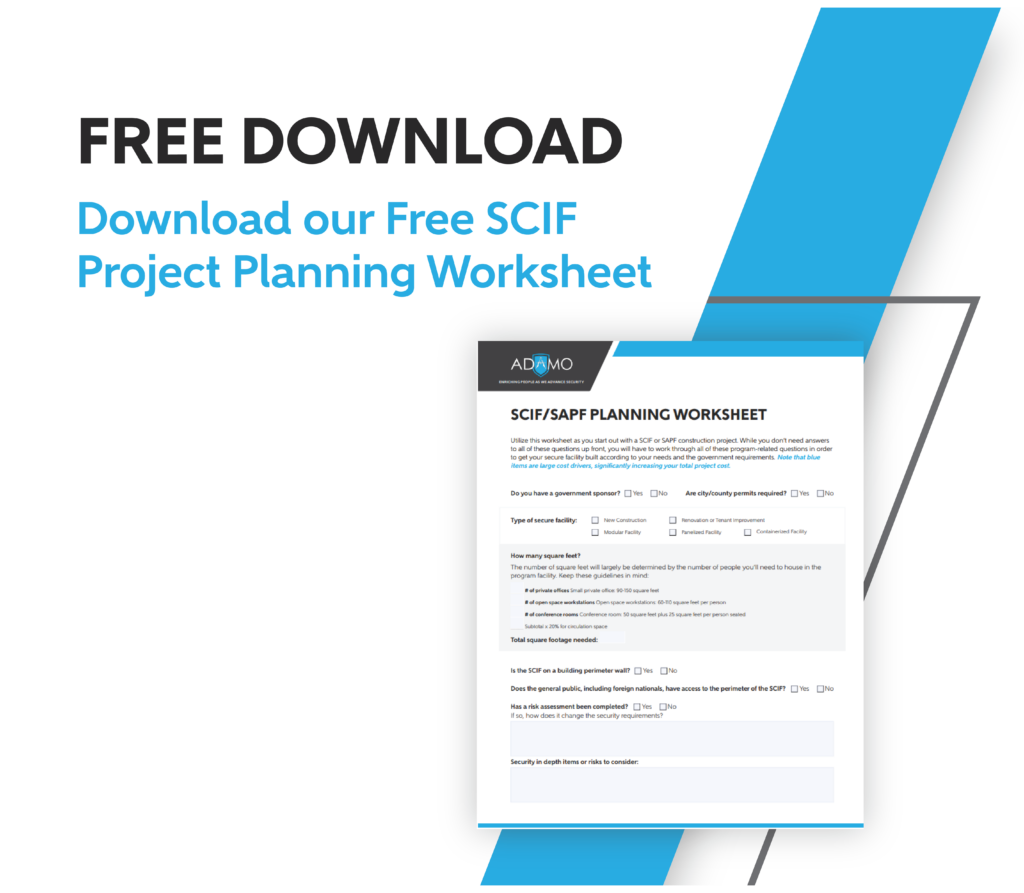Navigate and avoid the most common hurdles in the SCIF/SAPF accreditation process.
The final step in having an operating Sensitive Compartmented Information Facility (SCIF, pronounced “skiff”) is getting it approved for accreditation. Oftentimes, SCIF building projects can come up against hurdles in the accreditation phase that result in costly delays. According to the ICD 705 Tech Spec, the responsibility for getting a SCIF approved for accreditation falls on the Site Security Manager (SSM). However, every stakeholder in the project will want to avoid spending more time and money than expected to get their facility accredited. Below is a list of common hurdles in the accreditation process and how to avoid them so that your project stays on track and is accredited with little disruption to your timeline and budget.

Hurdle #1: Coordinating with Outside Parties
The No. 1 hurdle in the accreditation phase is coordinating with the necessary third-party government representatives, primarily your Accrediting Official (AO). These representatives have large caseloads, so their availability can be slim. More often than not, your AO will want to do a site visit, so you will have to line up travel arrangements and meeting times to accommodate. To minimize this hurdle, don’t wait until construction is complete to learn your AO’s availability. Start coordinating with them early. However long you think you will need, it’s best to start before that. There really is no such thing as “too soon” when it comes to this aspect of working toward getting your facility accredited.
Hurdle #2: An SSM’s Knowledge of Construction
Most likely your SSM is well versed in physical or program security, but there’s a chance they lack the professional background in construction to easily speak to the various specific elements of your project. If that’s the case in your situation―that the SSM on your project isn’t confident in their ability to discuss the ins and outs of construction, IT and telecommunication equipment, etc.―then the best way to side-step this hurdle is for the SSM to collaborate with your contractor and any specialists for the specifics of the project. This will help the SSM clearly communicate what they need in order to complete the Fixed Facility Checklist (FFC).
Hurdle #3: Robust and Complicated Building Plans
The construction documents a builder uses to build a project are usually very robust and full of detailed information. It is the AO’s job to understand how your SCIF is built, but because of their large caseloads, they don’t usually have the time to sift through these documents or extensive blueprints to find the bits of information they need. Therefore, the AOs often prefer to ask questions to learn what they need to know instead of reviewing and reading the plans that can be hundreds of pages long because it’s easier and faster for them. This, however, causes a back-and-forth trickle of information, most often through emails, which further leads to latency in the accreditation.
To avoid this frustrating back-and-forth, have a subset of drawings that are simplified and that only speak to the security information needed. If the SSM of the project is skilled in drawing and drafting, they can create these. If not, it would be most efficient and advantageous to hire a consultant to come into the project for this reason.
Hurdle #4: Completing Your Required Checklist(s)
For a SCIF to be accredited, a Fixed Facility Checklist (FFC, also mentioned in Hurdle #2) must be submitted. There are often additional official checklists that are required based on the purpose or location of your SCIF (such as the TEMPEST Checklist and Compartmented Area Checklist), so keep in mind this information can apply to all of them. These checklists can present a two-fold hurdle because there are a couple of misconceptions surrounding completing them.
First to note, many people wait until construction is complete before working through their required checklists, thinking they will be able to walk through their project once it’s done and simply cross things off. However, it is not wise to save working through the checklist until the end of construction because you will likely find items that need to be addressed and reworked. This can be very difficult to do because the elements of your project have already been considered finalized but will require more time and money to correct.
Therefore, to avoid this hurdle, it is best to keep any checklists as a working document from the very beginning of your project, checking items off along the way so each requirement is met when you reach completion of construction. Don’t wait until the end of your project to start looking at your checklists.
Secondly, there is a common misconception that once your checklists are complete, your project is ready to be accredited. But, in reality, you will also need to have your program management documents, such as Standard Operating Procedures and Emergency Action Plans, ready to submit as well. Your AO will want to review these before your SCIF can receive accreditation.
To be sure you have all your documents in order and are prepared for accreditation, the SSM should make a master checklist of not only what is needed to be accredited but also what is needed for your SCIF to be considered functional and ready for operation. This can be created and used at the beginning of construction, after the design phase.
Hurdle #5: Material Delays and Increased Lead Times
Project timelines have been drastically affected by material delays due to the COVID-19 pandemic. Waiting for basic electrical parts including light fixtures, breakers and panels can delay a project by several months. Cost and availability of some products have become unpredictable, causing materials like lumber to as much as double in cost between 2019 and 2022. RF shielding materials face some of the greatest delays.
While this hurdle is difficult to avoid, proper planning can help mitigate issues. Know specifically what each project needs and try to avoid major changes in design. Any changes that affect the quantities of materials needed or changes in specialized parts will reset lead times on materials with already long waits.
Hurdle #6: Making Changes After Construction is Complete but Before Accreditation
There are a few contributing factors that could cause you to need to make changes to your SCIF construction once you thought it was complete but before it was accredited. First, it was simply built wrong from the beginning. If you did not have an expert on your team in the design phase, or have your sponsor sign off on the plans and configuration, then it is not far-fetched for your AO to find that something was missed or improperly constructed and thus not able to push your project forward to accreditation.
If you find yourself in this situation, your contractor has likely moved on to their next project, and now you face major challenges in getting them back to make changes. To avoid this, be sure to have an expert on your build team or a consultant that can best advise you from the start of your project. Likewise, it is a good idea to have your AO and sponsor approve your plans to avoid building on risk. If your AO does not sign off on your plans before construction is complete, the ICD 705 states that the government has no obligation to accredit you.
Another reason you might encounter major adjustments needed before accreditation can occur is if you experience a change in personnel with your AO. Every project has the possibility of encountering a change in personnel, but this is especially common among long-running projects with government officials. We often see these officials getting promoted or making lateral career changes that will likely cause you to find yourself with a new AO at some point during your project.
With this change, you might also experience a change in an AO’s security approach and what they deem as acceptable. Where one element of your facility might have been considered safe and acceptable by one official, it could be seen as unacceptable by another. Obviously, this can cause a project to stall and require you to go back and rectify something you had already considered final. This, again, can be particularly challenging if you now have to arrange to get your contractor back in to do the work when they had already considered the project complete.
In an effort to avoid this hurdle, it is best to thoroughly document every unique and situational decision your AO makes regarding your project and the discussions around these decisions. This will make it easy for the new AO to see what was agreed upon and why when they step into the role. You can document these items really well in your construction security plan, or CSP.
If you’re starting on your path to building a SCIF or SAPF and feel overwhelmed or don’t know where to start, check out Adamo’s SCIF/SAPF Planning Worksheet. This worksheet asks the major questions you need to know to make your project a success from the start.
Editor’s Note: This article was written in 2021 and was updated in 2022 to include current information about material delays and increased lead times.




